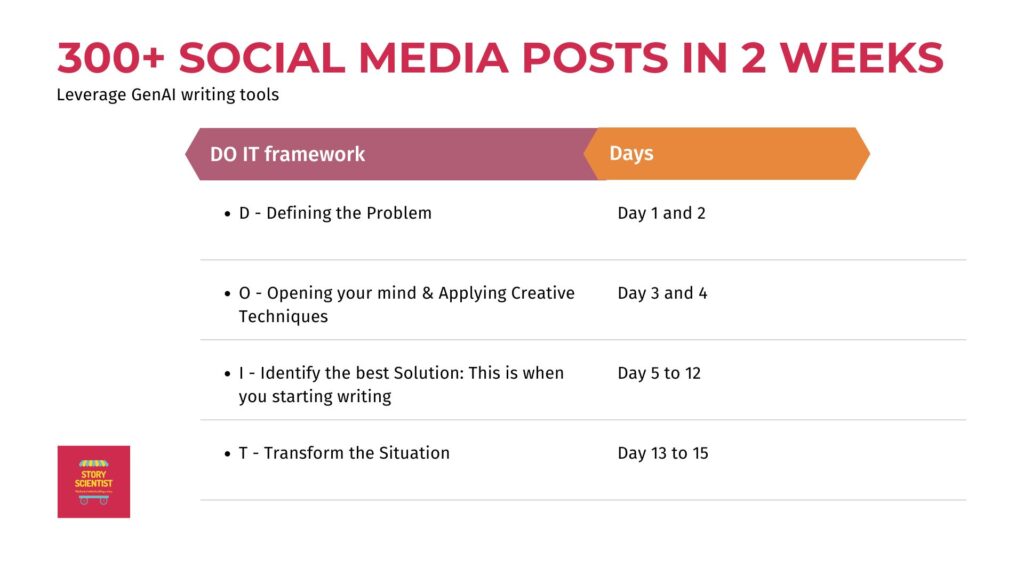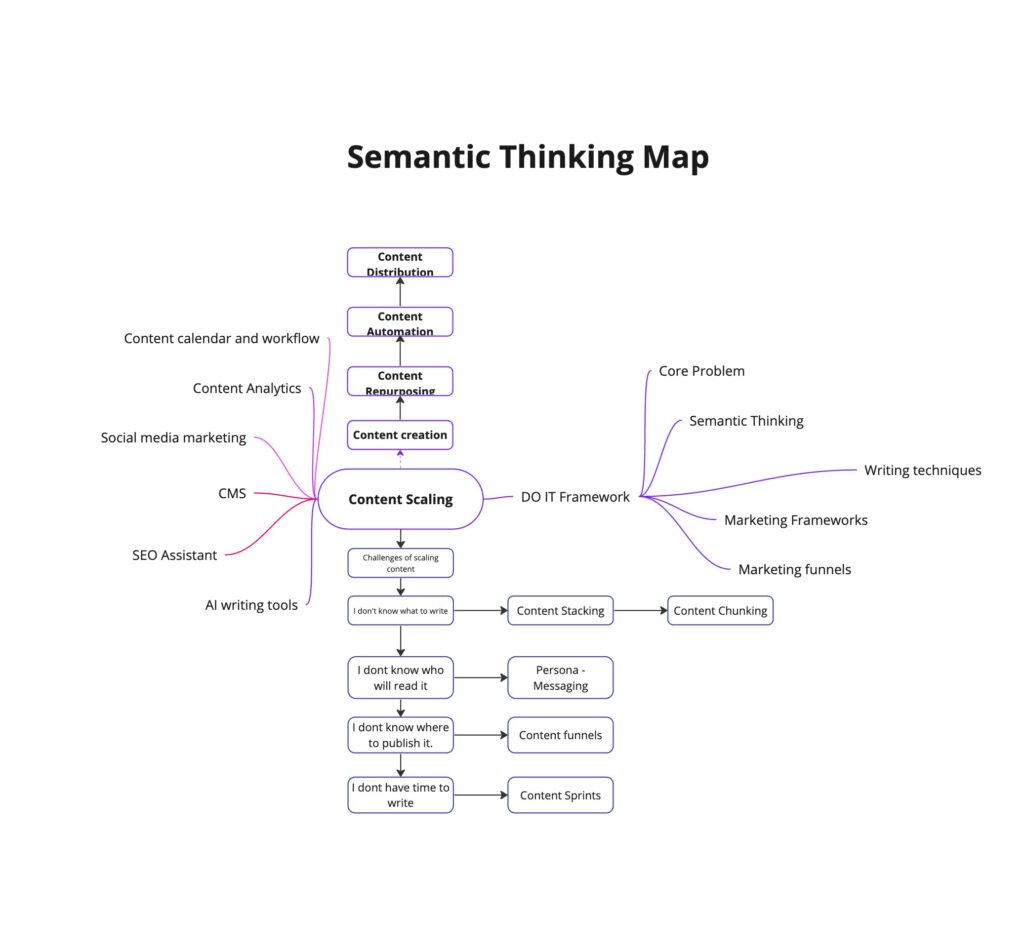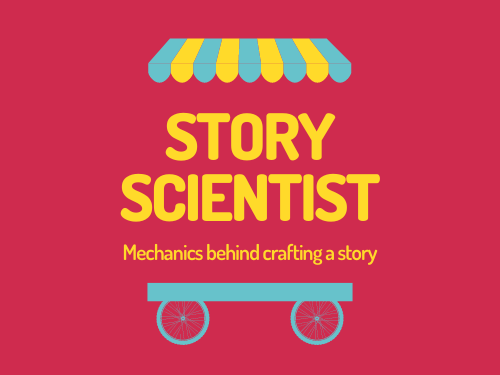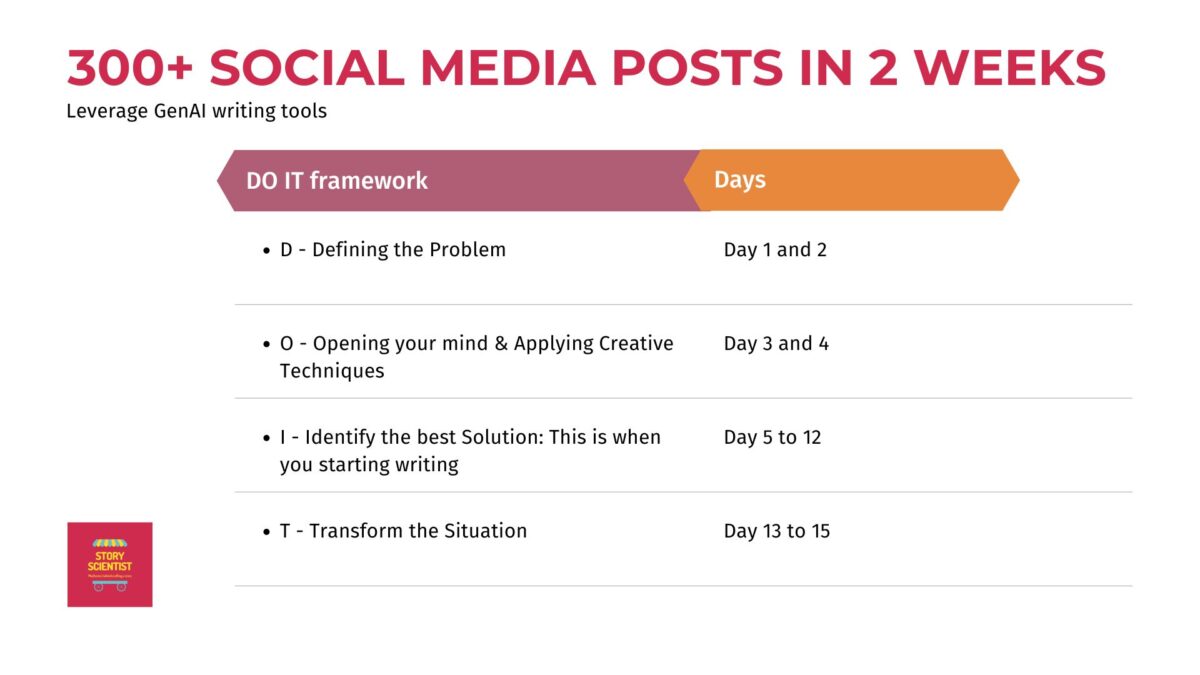How I created 300+ personalized posts in less than 2 weeks using the DO IT Framework?
I failed multiple times to keep the “writing habit” consistent. Working on other priorities or my sick child took precedence of my good intentions to write everyday or rather show up on Linkedin at a designated time.
We are humans. We succumb to emotions and environment. This has been true with me too. It was not my lack of discipline or good intentions. I failed because I didn’t set myself up for success. The systems that I used did not suit me and were outdated. It did not support a family person with a life outside work.
These systems did not suit my lifestyle, my job, my personal constraints.
To validate my curious mind, I ran a survey. It revealed that four aspects of unknowns are creating the trouble.
I evaluated 84 responses. The four most common reasons that my respondents identified with were:
- I don’t know who will read it
- I don’t know what to write
- I don’t have time to write
- I don’t know where to publish
I went on to resolve these grey areas with a content experiment. It is called Think Code OS.
| The Unknown | Real Challenge | How to solve it? |
|---|---|---|
| I don’t know who will read it | No Audience | Create Personas and align the right Messaging. |
| I don’t know what to write | No Ideas | Semantic mapping for ideation and then use Content Stacking and Content Chunking |
| I don’t have time to write | No Time | Accelerate writing with Content Sprints |
| I don’t know where to publish | No Channel | There is no single place. There is always a place for attention and a place for conversion. Deep dive into Content Funnels |
I created a system called Think Code OS that helped me create 300+ social media posts and articles for my Linkedin cadence in about 2 weeks.
Disclaimer: While all this can be done manually, I have used a combination of FREE AI writing tools such as ChatGPT, Google Gemini, and Claude AI.
The system is based on a framework called DO IT.
DO-IT: A Creative thinking framework to scale your content in 2 weeks.
DO IT was originally recommended by Robert W Olsen in his book ‘The Art of Creative Thinking’. It is a creative thinking model. As simple as it might sound, it is very powerful and I have applied it here to scale content.
D – defining the problem
O – opening your mind and applying creative techniques
I – identifying the best solution
T – transforming the situation
If you also want to learn how to generate over 90 to 300 content ideas in alignment with your marketing goals, sign up for Think Code OS.

Step #1 What is the Core Problem that you are trying to solve?
This step takes 2 – 3 days.
For Founders and Solopreneurs who are building their own personal brand, defining the core problem is about “defining the movement that you want to lead”. Like Justin Welsch says,” For him, his movement is about helping get out of the 9 to 5 job cycle.” For Dan Joe it is all about the ‘The Art of Focusing’. For James Clear, it is about helping people achieve their goals by changing their habits and sticking to good ones.
For me, it to be able to use technology to unravel creativity.
What is yours?
For instance, Think Code OS helps anybody who wants to write, ramp up their content game. With the help of GenAI writing tools, this system taps into the thinking abilities and empowers them to write.
| Who are we solving it for? | What is the core problem that we are solving? |
|---|---|
| Co-founder & Founder | Showing up everyday in front of potential customers |
| VPs & Senior leaders | Personal branding for employability and better hiring opportunities with thought leadership |
| Agency owners – marketing | Getting more clients by creating more content and scaling it. Give them a LIVE proposal with a 90-day content calendar. |
| Product Marketers | Scaling content to increase top of the funnel leads and champion the product. |
| Product Managers | Better Thought Leadership while working on the content for GTM. |
| Content Marketers | Scaling content and writing better stories that lead to the intended response of their audience. |
| Freelance Content writers or Solopreneurs | Personal branding, building relationships, and generating leads. |
Think Code OS helps aspiring thought leaders define their core problem, even before they plunge into content creation.
Step #2 How to open your mind and apply creative techniques?
This step takes 2 – 3 days.
Asking questions and finding answers satiates ‘curiosity’. But, how do you actually open your mind.
Step A: Semantic thinking is the answer.
If you thought this has something got to with Search Engine Optimization (SEO), then hold it. SEO has adopted the process of ‘Semantic keyword building’ from psychology. Semantic is a study of how meaning is stored in the mind.
This process helps in building a wide net of coherent ideas in a single visual map. For instance, take a look at the map that is created for writing this article.

We use GenAI tools to create something similar for us and build upon it to create a lot of meaningful content in a short time. In the course Think Code OS for SEO specialists, I will be revealing and sharing, how to use GenAI writing tools to create semantic structures and add more authority to your website content.
Step B: Using Marketing Frameworks that matter to sales.
After this I used a set of marketing frameworks to help me categorize these entities and topics into the buckets based on my business goals.
It gave me a direction about which topics to choose. I was able to align my time, effort and money on generating content that helps me increase my course subscriptions.
This helped me generate a 90-day content calendar that helped me tie back my personal stories, my experiences to my work and create 300+ social media posts around them.
By marketing stage of the funnel
But these story ideas were classified based on the marketing stage of the funnel.
- Top of the funnel (TOFU)
- Middle of the funnel (BOFU)
- Bottom of the funnel (BOFU)
I further used these marketing frameworks to understand which human emotions should be targeted, which level of customer awareness would it kindle and which of those posts would meet the right customer mindset.
They were story ideas only.
I had not yet started actually writing them.
Step #3: Identifying which Writing solution and style works for these stories.
Allocate 7 – 8 days for this step.
This is the longest and meticulous part. But thanks to the Story Scientist Framework which clearly identifies which writing structure works for which type of content goal, all I had to do is share examples and ChatGPT did the grunt work. It clearly classified how I need to write each of those story ideas.
After classifying, I used 7 – 8 different writing structure frameworks to spin stories. Writing, feedback, editing, and pruning took almost 7 days to complete it.
Module 3 of Think Code OS focuses on how to use different writing techniques and models to craft messages.
Step #4: Transforming the situation
This step took about 3 to 4 days.
With all the stories ready to publish, I had to make one last tweak. I had already classified them by goals, now I needed to add the CTAs to align them to the final conversion.
Not all stories were meant for selling. Some were to prime readers to get ready to purchase, some were to draw attention, some were to educate and others were to sell.
Every content piece out there, especially in the B2B arena leads to achieving one of the following: For me it was all about matching every story to one of the following goal.
- Newsletter subscriptions
- Book a meeting
- Free Trial sign ups
- Product Purchase
Sign up here to practice and learn how to apply Think Code OS.
So, I created funnels to achieve each one of my goals. My messages were created for the following micro goals:
- Linkedin Follower
- Newsletter Subscriber
- Lead Magnet Subscribers
- Book a Meeting Sign ups
- Paid Course Sign ups
But not everyone would want all of it. Depending on the level of awareness of the problem and solution and the mindset, people would go down to engage with my messages and reach the end of the funnel achieving one or most of the goals mentioned.
This required me to map my personas and the funnels.
PRO TIP: If you have small content teams, prioritize which target audience you want to go ahead with.
Module 4 of Think Code OS walks you through this and helps you achieve your goal with the help of funnels.
HERE IS HOW I CAN HELP YOU.
- If you are a senior professional looking to improve your personal brand and employability, I can help you create these ideas personalized to you.
- I can coach your content teams to create social media ideas for your brand.
- If you are an agency owner, I can help you improve your teams’ bandwidth by creating more using the same resources.
- If you are a course creator, I can help you create consistent social media content to keep your personal brand relevant.

